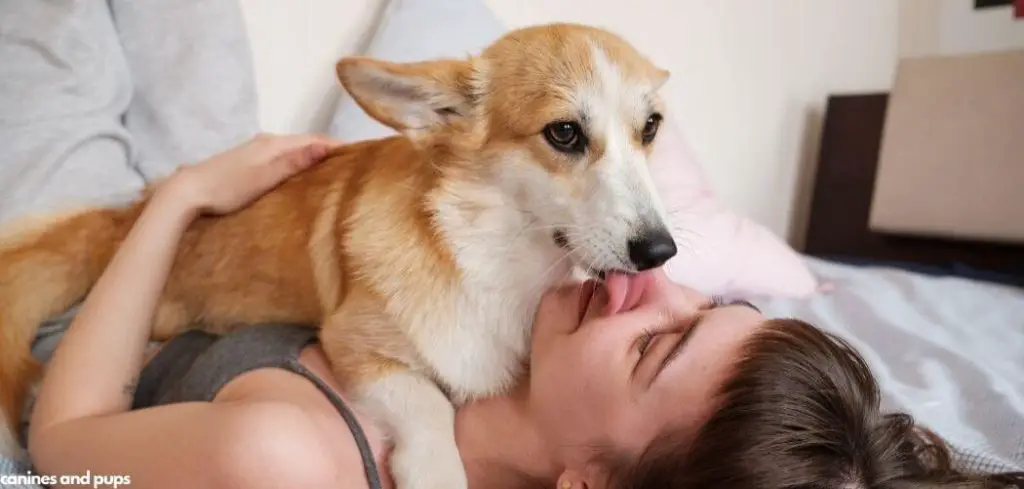Seeing your dog panting while jumping on you can be concerning and sometimes confusing. Panting is a normal way for dogs to cool down, but when paired with jumping, it may indicate excitement or an underlying medical or behavioral issue.
We outline the common reasons why dogs may pant and jump on you, what you can do, and when to seek veterinary help.
Dog Panting and Jumping on Me — Why It Happens
When a dog is panting and constantly jumping on you, it’s usually a sign of excitement, anxiety, or an attempt to get attention. Panting can occur as part of the dog’s arousal response—whether from playfulness, stress, or overstimulation—while jumping is a way to seek closeness or reassurance.
This behavior is common when dogs are eager to interact or feel uneasy and want comfort from their owner. However, excessive panting or frantic jumping may indicate anxiety, fear, or a medical issue causing restlessness.
Observing when and how often it happens can help determine if it’s behavioral or health-related.

Dog Panting and Jumping on Me: Common Causes
Excitement and Playfulness
Panting and jumping often occur when dogs are excited. Your dog may be eager to greet you, play, or express joy.
Look for wagging tails, playful barks, and energetic movements. While generally harmless, excessive jumping can become overwhelming or dangerous if not managed.
Teaching calm greetings can help reduce overexcitement while keeping your dog happy and engaged.
Read more: Dog Panting and Licking Me (Here’s why)
Anxiety or Stress
Dogs may pant and jump on you when anxious or stressed. Panting in this context signals a heightened state of arousal, and jumping may be a coping mechanism.
Symptoms often include pacing, whining, trembling, or avoiding certain areas. Understanding triggers, providing reassurance, and gradually training alternative behaviors can help reduce anxiety-related jumping.
Attention-Seeking Behavior
Panting and jumping can be a way for dogs to seek attention. Dogs quickly learn that jumping on you results in petting, talking, or play.
If reinforced unintentionally, this behavior can become habitual. Consistently rewarding calm behavior instead of jumping teaches your dog more appropriate ways to get attention while reducing panting from overexcitement.
Excess Energy or Lack of Exercise
Dogs with pent-up energy may pant and jump excessively. Insufficient physical or mental stimulation leads to hyperactive behavior.
Signs include restlessness, zoomies, and inappropriate play behaviors. Ensuring your dog has regular walks, playtime, and mental enrichment helps reduce unwanted jumping and panting caused by excess energy.
Medical Causes
Sometimes, panting alongside jumping can indicate an underlying medical issue. Pain, fever, heart problems, or respiratory difficulties may cause your dog to pant more frequently.
Even if the jumping seems playful, frequent or labored panting warrants a checkup. Look for other signs such as lethargy, coughing, or changes in appetite, and consult your veterinarian promptly.
Breed or Age Factors
Certain breeds and ages are more prone to panting and jumping. High-energy breeds, such as Border Collies or Terriers, naturally have higher activity levels, while puppies and young dogs often exhibit exuberant behavior.
Understanding your dog’s breed tendencies and age-related energy helps you anticipate behaviors and implement training strategies that reduce both panting and jumping.
What to Do If Your Dog Is Panting and Jumping on You
Encourage calm greetings by ignoring your dog when they jump and only providing attention when all four paws are on the floor. Rewarding calm behavior helps teach appropriate ways to interact.
Provide consistent exercise and mental stimulation through walks, games, and puzzle toys to reduce excess energy that can lead to panting and jumping.
Address anxiety triggers gradually using desensitization and positive reinforcement. For example, practicing brief separations or controlled greetings can help your dog feel more secure.
Avoid punishing your dog harshly for jumping or panting, as this can increase stress and worsen the behavior. Gentle redirection and training exercises are more effective and maintain trust.
Consult your veterinarian if panting appears excessive, labored, or is accompanied by other symptoms. This ensures that underlying medical conditions are identified and managed promptly.
When to Call or Visit Your Vet
Seek veterinary attention if your dog exhibits:
Labored or heavy panting
Panting at rest or without apparent cause
Sudden changes in behavior or activity level
Signs of pain, discomfort, or illness
Persistent anxiety or stress-related behaviors
Your veterinarian can conduct a physical examination, assess heart and respiratory health, and provide guidance on managing behavior and any medical concerns. Early intervention ensures both safety and well-being.
Read more: Dog Panting and Barking at Me (Here’s Why)
Key Takeaway
Panting and jumping on you can be caused by excitement, anxiety, attention-seeking, excess energy, medical issues, or breed and age factors.
Observing your dog, providing consistent exercise, implementing calm greeting training, and seeking veterinary guidance when needed are essential steps.
Proper management ensures your dog remains healthy, happy, and well-behaved while reducing excessive panting and jumping.
